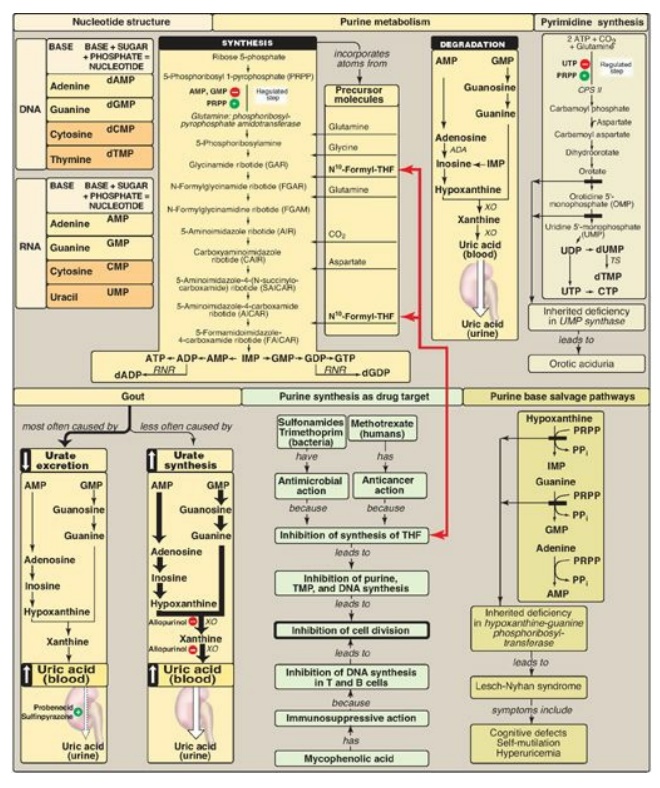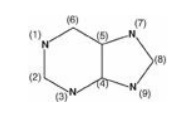Chapter Summary, Questions Answers - Nucleotide Metabolism
| Home | | Biochemistry |Chapter: Biochemistry : Nucleotide Metabolism
Nucleotides are composed of a nitrogenous base (adenine = A, guanine = G, cytosine = C, uracil = U, and thymine = T); a pentose; and one, two, or three phosphate groups.
CHAPTER SUMMARY
Nucleotides are
composed of a nitrogenous base (adenine = A, guanine = G, cytosine = C, uracil
= U, and thymine = T); a pentose; and one, two, or three phosphate groups
(Figure 22.24). A and G are purines, and C, U, and T are pyrimidines. If the
sugar is ribose, the nucleotide is a ribonucleoside phosphate (for example,
adenosine monophosphate [AMP]), and it can have several functions in the cell,
including being a component of RNA. If the sugar is deoxyribose, the nucleotide
is a deoxyribonucleoside phosphate (for example, deoxyAMP), and will be found
almost exclusively as a component of DNA. The committed step in purine synthesis
uses 5-phosphoribosyl-1- pyrophosphate ([PRPP], an “activated pentose” that
provides the ribose-phosphate group for de novo purine and pyrimidine synthesis
and salvage) and nitrogen from glutamine to produce phosphoribosyl amine. The
enzyme is glutamine:PRPP amidotransferase and is inhibited by AMP and guanosine
monophosphate ([GMP] the end products of the pathway) and activated by PRPP.
Purine nucleotides can also be produced from preformed purine bases by using salvage
reactions catalyzed by adenine phosphoribosyltransferase (APRT) and
hypoxanthine-guanine phosphoribosyltransferase (HGPRT). A near-total deficiency
of HGPRT causes Lesch-Nyhan syndrome, a severe, heritable form of hyperuricemia
accompanied by compulsive self-mutilation. All deoxyribonucleotides are
synthesized from ribonucleotides by the enzyme ribonucleotide reductase. This
enzyme is highly regulated (for example, it is strongly inhibited by
deoxyadenosine triphosphate [dATP], a compound that is overproduced in bone marrow
cells in individuals with adenosine deaminase deficiency). This syndrome causes
severe combined immunodeficiency disease. The end product of purine degradation
is uric acid, a compound whose overproduction or undersecretion causes
hyperuricemia that, if accompanied by the deposition of monosodium urate
crystals in joints and soft tissues and an inflammatory response to those
crystals, results in gout. The first step in pyrimidine synthesis, the production
of carbamoyl phosphate by carbamoyl phosphate synthetase II, is t he regulated
step in this pathway (it is inhibited by uridine triphosphate [UTP] and
activated by PRPP). The UTP produced by this pathway can be converted to
cytidine triphosphate. Deoxyuridine monophosphate can be converted t o
deoxythymidine monophosphate using thymidylate synthase, an enzyme targeted by
anticancer drugs such as 5-fluorouracil. The regeneration of tetrahydrofolate
from dihydrofolate produced in the thymidylate synthase reaction re q ui re s
dihydrofolate reductase, an enzyme targeted by the drug, methotrexate. Pyrimidine
degradation results in soluble products.

Figure 22.24 Key concept map
for nucleotide metabolism. THF = tetrahydrofolate; ADA= adenosine deaminase; XO
= xanthine oxidase; TS = thymidylate synthase; RNR = ribonucleotide reductase;
CPS II = carbamyl phosphate synthetase II; AMP = adenosine monophosphate; GMP =
guanosine monophosphate; CMP = cytidine monophosphate; TMP = thymidine
monophosphate; IMP = inosine monophosphate; d = deoxy; PPi = pyrophosphate.
Study Questions
Choose the ONE correct answer.
22.1 Azaserine, a drug with research applications,
inhibits glutamine-dependent enzymes. Incorporation of which of the ring
nitrogens (N) in the generic purine structure shown would most likely be
affected by azaserine?
A. 1
B. 3
C. 7
D. 9

Correct answer = D. The nitrogen (N) at position 9 is
supplied by glutamine in the first step of purine de novo synthesis, and its
incorporation would be affected by azaserine. The N at position 1 is supplied
by aspartate and at position 7 by glycine. The N at position 3 is also supplied
by glutamine, but azaserine would have inhibited purine synthesis prior to this
step.
22.2 A 42-year-old male patient undergoing
radiation therapy for prostate cancer develops severe pain in the metatarsal
phalangeal joint of his right big toe. Monosodium urate crystals are detected
by polarized light microscopy in fluid obtained from this joint by
arthrocentesis. This patient’s pain is directly caused by the overproduction of
the end product of which of the following metabolic pathways?
A. De novo pyrimidine
biosynthesis
B. Pyrimidine
degradation
C. De novo purine
biosynthesis
D. Purine salvage
E. Purine degradation
Correct answer = E. The patient’s pain is caused by
gout, resulting from an inflammatory response to the crystallization of excess
urate in his joints. Radiation therapy caused cell death, with degradation of
nucleic acids and their constituent purines. Uric acid, the end product of
purine degradation, is a relatively insoluble compound that can cause gout (and
kidney stones). Pyrimidine metabolism is not associated with uric acid
production. Overproduction of purines can indirectly result in hyperuricemia.
Purine salvage decreases uric acid production.
22.3 Which one of the following enzymes of
nucleotide metabolism is correctly paired with its pharmacologic inhibitor?
A. Dihydrofolate reductase—methotrexate
B. Inosine
monophosphate dehydrogenase—hydroxyurea
C. Ribonucleotide
reductase—5-fluorouracil
D.Thymidylate synthase—allopurinol
E. Xanthine
oxidase—probenecid
Correct answer = A. Methotrexate interferes with
folate metabolism by acting as a competitive inhibitor of the enzyme
dihydrofolate reductase. This starves cells for tetrahydrofolate and makes them
unable to synthesize purines and thymidine monophosphate. Inosine monophosphate
dehydrogenase is inhibited by mycophenolic acid. Ribonucleotide reductase is
inhibited by hydroxyurea. Thymidylate synthase is inhibited by 5-fluorouracil.
Xanthine oxidase is inhibited by allopurinol. Probenecid increases renal
excretion of urate but does not inhibit its production.
22.4 A 1-year-old female patient is lethargic,
weak, and anemic. Her height and weight are low for her age. Her urine contains
an elevated level of orotic acid. Activity of uridine monophosphate synthase is
low. Administration of which of the following is most likely to alleviate her
symptoms?
A. Adenine
B. Guanine
C. Hypoxanthine
D. Thymidine
E. Uridine
Correct answer = E. The elevated excretion of orotic
acid and low activity of uridine monophosphate (UMP) synthase indicate that the
patient has orotic aciduria, a rare genetic disorder affecting de novo
pyrimidine synthesis. Deficiencies in one or both catalytic domains of UMP
synthase leave the patient unable to synthesize pyrimidines. Uridine, a
pyrimidine nucleoside, is a useful treatment because it bypasses the missing
activities and can be salvaged to UMP, which can be converted to all the other
pyrimidines. Although thymidine is a pyrimidine nucleoside, it cannot be
converted to other pyrimidines. Hypoxanthine, guanine, and adenine are all
purine bases and cannot be converted to pyrimidines.
22.5 What laboratory test would help in
distinguishing an orotic aciduria caused by ornithine transcarbamylase deficiency
from that caused by uridine monophosphate synthase deficiency?
Blood ammonia level
would be expected to be elevated in ornithine transcarbamylase deficiency but
not in uridine monophosphate synthase deficiency.
Related Topics
